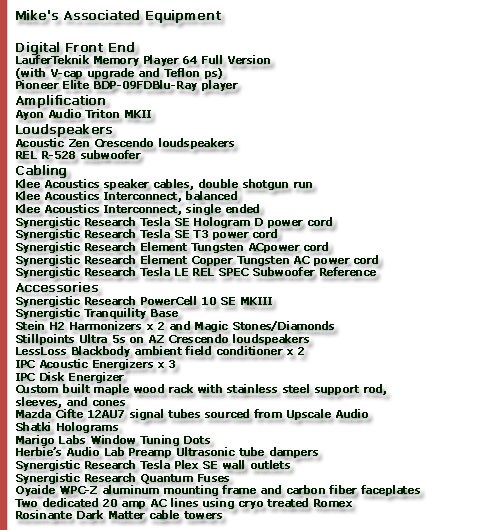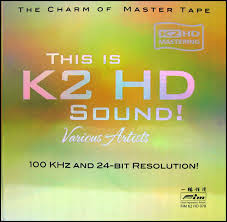Synergistic Research Tranquility Base

 Back in January of 2013, I had the pleasure of reviewing the Synergistic Research Powercell 10SE MKIII, Element Series power cables, and MiGs. Considering the improvements realized at that time, and their recognition as Stereo Times “Most Wanted Components,” it became obvious to me that I had follow-up with reviews of other SR audio products. The device under test (DUT) in this review includes the mid-level SR Tranquility Base (Base).
Back in January of 2013, I had the pleasure of reviewing the Synergistic Research Powercell 10SE MKIII, Element Series power cables, and MiGs. Considering the improvements realized at that time, and their recognition as Stereo Times “Most Wanted Components,” it became obvious to me that I had follow-up with reviews of other SR audio products. The device under test (DUT) in this review includes the mid-level SR Tranquility Base (Base).
The Tranquility Base concept was born from the challenge to improve the performance of computer audio. The approach was to eliminate the interaction between internal components such as power supplies, inductors, IC chips, closely positioned circuits, and printed circuit boards within the computer as opposed to filtering the incoming AC line and line level signals. Application of the Tranquility Base approach was later extended to all audio components in addition to digital based audio. The implementation of the EM Cell in the Tranquility Base is analogous to the way the patented EM Cell is implemented in the SR PowerCell line conditioner I previously reviewed.
The Tranquility Base is offered in three different configurations based on size and performance levels:
Tranquility Bāsik ($995)
• Level 1 Active Signal Flow Control
• Seven layer laminate mechanical isolation
• One set of MiG resonator footers
• 17” wide x 14” deep x 1″ tall
Tranquility Base ($1995)
• Level 2 Active Signal Flow Control
• Level 1 Passive Ground Plane
• Nine layer laminate mechanical isolation
• Two sets of MiG resonator footers
• 18.5” wide x 16” deep x 1.5″ tall
Tranquility Base XL ($2995)
• Level 2 Active Signal Flow Control
• Level 1 Passive Ground Plane
• 9 layer laminate mechanical isolation
• One set of MiG resonators and one set of BIG MiG resonator footers
• 20” wide x 23” deep x 1.5″ tall
• Amp stand for large stereo and mono block amplifiers
• A direct replacement for shelves on large Grand Prix racks
The Tranquility Base is a well-designed platform consisting of a nine layer dark acrylic laminate top and a machined aluminum base with a brushed aluminum rim. EM cells are located below the nine layer laminate top. An active layer of EM cells are located below the nine layer laminate top. There are three receptacles located on the back panel of the Base which provide the following: a) ground wire provided with its own AC wall plug, b) Enigma Bullets used to fine tune the active sound of the Base (two are provided), and c) power supply known as a Mini Power Coupler (MPC). Six MiG (Mechanical Interface Grounding) footers are included to isolate the component and Base. The Base set of three MiGs should be installed with the rounded surface down. The component set of MiGs allow the user the ability to fine tune the sound field based on the set-up. The MiGs are said to “re-tune a component’s mechanical resonance, while providing a lightning fast drain of mechanical energy to ground” and can be optimized in their configuration. My review of the extremely effective SR MiGs and the improvement brought in by the EM cell as implemented in the SR PowerCell line conditioner can be found here.
Since the Base is an active component the effect of the EM Cells on the audio performance can be easily determine by simply unplugging the MPC. My review will start with baselining my system sans the Tranquility Base. I will then install the Tranquility Base under my Laufer Teknik Memory Player 64 Full Version and report on the results.
Tranquility at Last
 My reviewing system includes the Laufer Teknik Memory Player 64 Full Version Player, Pioneer bdp-09fd blu ray player, Ayon Audio Triton MKII integrated amplifier fitted with Ayon BT SX KT88 power tubes and Mazda Cifte signal tubes, Acoustic Zen Crescendo loudspeakers, REL R-528 subwoofer, Klee Acoustics speaker cables and interconnects, Synergistic Research Tesla LE REL SPEC Subwoofer Reference cable, Synergistic Research Element AC power cords, Synergistic Research PowerCell 10 SE MKII conditioner, Synergistic Research Tesla Plex SE outlets, IPC Acoustic Energizers, Stein H2 Harmonizers and Magic Stones, Shatki Hallograph, Stillpoints Ultra 5s footers and LessLoss Blackbodies behind the AZ Crescendo loudspeaker crossovers. As for my listening area, its 14.5’ wide, has a 9’ ceiling, and has an open back wall to 1500 sqft of first floor living area.
My reviewing system includes the Laufer Teknik Memory Player 64 Full Version Player, Pioneer bdp-09fd blu ray player, Ayon Audio Triton MKII integrated amplifier fitted with Ayon BT SX KT88 power tubes and Mazda Cifte signal tubes, Acoustic Zen Crescendo loudspeakers, REL R-528 subwoofer, Klee Acoustics speaker cables and interconnects, Synergistic Research Tesla LE REL SPEC Subwoofer Reference cable, Synergistic Research Element AC power cords, Synergistic Research PowerCell 10 SE MKII conditioner, Synergistic Research Tesla Plex SE outlets, IPC Acoustic Energizers, Stein H2 Harmonizers and Magic Stones, Shatki Hallograph, Stillpoints Ultra 5s footers and LessLoss Blackbodies behind the AZ Crescendo loudspeaker crossovers. As for my listening area, its 14.5’ wide, has a 9’ ceiling, and has an open back wall to 1500 sqft of first floor living area.
I installed the Base under the Laufer Teknik MP and allowed the Base to burn in for 72 hours. When evaluating the Base, one should note the additional height required since it will raise the treated component a total 3.7”. I started with the “silver” Enigma Tuning bullet which is said to be open and airy and is preferred 95% of the time. Based on my initial impressions and my experience with SR bullets on the Element power cords, I was sure it would be the best match for my tube based system. I then decided to try the “grey” bulletwhich was preferred and for me it made a significant difference. It’s surprising that some reviewers could not distinguish the difference between the two bullets.
Robert Plant/Alison Krauss, Raising Sand (Rounder), as an HD track 24 bit/96k Hz download, is one of my go to evaluation recordings. This album is a Grammy-award winning collaboration album by rock singer Robert Plant of Led Zepplin and bluegrass-country singer Alison Krauss. Alison Krauss’s voice has been described as “spellbinding”, “honey-sweet”, “weepy”, “saccharine”, and “haunting”. For starters, the Base distinguished itself in the most important area, the midrange. With the Base employed, Alison’s voice was more captivating, sweeter, more natural, and projected more into the room. I’ve always thought my speakers disappeared well but with the Base energized, there was a dramatic reduction in the room/speaker interaction with respect to the soundstage portrayal. I really noticed the reduction in my system’s noise floor. With the lower noise floor, I was able play my system at a much higher volumewhere previously my system’s sound would start to lose its resolving clarity. Overall each instrument had greater depth (particularly stringed instruments in this album), the frequency extremes were better defined/controlled, transients were articulated more crisply, the surrounding ambience had greater clarity, and the music was more relaxed (and so was I).
Since I can appreciate a fine video performance; I’ll make some analogies here. The Base calibrates the treated component similar to when a high definition display device receives a professional ISF calibration. In an ISF calibration, the contrast, brightness, color accuracy, grey scale, etc. are optimized to achieve the best possible picture. The Base optimizes the treated component “internally” by negating the interaction of internal components to deliver the best possible sound.
 The second reference recording used to judge the effectiveness of the Base included selected cuts from This Is K2 HD Sound (FIM), upsampled to 32bit/96k. The first cut, “Symphonic Dances – No. 1 Non Allegro, Excerpt from Rachmaninoff” Reference Recordings HDCD (RR-96CD), was selected to evaluate the Base’s performance a classical piece. This is the first movement (‘Non allegro’) of Rachmaninov’s Symphonic Dances, recorded in Moscow in October 1995 by the State Symphony Orchestra of Russian Federation conducted by Yevgeny Svetlanov. The work is scored for an orchestra composed of piccolo, 2 flutes, 2 oboes, coranglais, 2 clarinets, bass clarinet, alto saxophone, 2 bassoons, contrabassoon, 4 horns, 3 trumpets, 3 trombones, tuba, timpani, triangle, tambourine, side drum, cymbals, bass drum, tamtam, xylophone, glockenspiel, tubular bells, harp, piano, and strings.
The second reference recording used to judge the effectiveness of the Base included selected cuts from This Is K2 HD Sound (FIM), upsampled to 32bit/96k. The first cut, “Symphonic Dances – No. 1 Non Allegro, Excerpt from Rachmaninoff” Reference Recordings HDCD (RR-96CD), was selected to evaluate the Base’s performance a classical piece. This is the first movement (‘Non allegro’) of Rachmaninov’s Symphonic Dances, recorded in Moscow in October 1995 by the State Symphony Orchestra of Russian Federation conducted by Yevgeny Svetlanov. The work is scored for an orchestra composed of piccolo, 2 flutes, 2 oboes, coranglais, 2 clarinets, bass clarinet, alto saxophone, 2 bassoons, contrabassoon, 4 horns, 3 trumpets, 3 trombones, tuba, timpani, triangle, tambourine, side drum, cymbals, bass drum, tamtam, xylophone, glockenspiel, tubular bells, harp, piano, and strings.
The super silent background allowed me to identify nearly each instrument and its placement within the orchestra with an enormous sense of space. The greater resolution drew me deeper into this recording as never before. There was also a greater sense of textures of bow on strings and the deep bass crescendos were more explosive as compared to my system sans the Base. Again, there my Crescendo speakers disappeared much better with the Base. These improvements brought by the Base were later confirmed on Lift Your Veil from “A Rose For Me” FIM XRCD24 (FIMSXR074). The fifth cut, Touch from”Touch” by Christopher Hardy JVC XRCD2 (JVCXR1040) was used to determine the effect of the Base on the bass response (no pun intended). This release New Age piece includes unique instruments such as the tar, water gong, wave drum, and the rainstick played by Christopher Hardy, an award winning percussionist with Kazumi Wantanabe on the guitar. With the Base employed, my AZ Crescendos delivered the deepest and tightest base output I have experienced yet. The ninth cut, Blue Dream for Jazz, from “A Tale of Foreign Lands” opens with a soprano saxophone and piano. Again with the Base energized, the soprano sax had more presence and was more liquid sounding. The piano was more natural sounding with a wider spacial distinction between the sax and itself. I’ve heard this piece many times and I was never more drawn into it until the Base was introduced into my system. Whatever style of music I threw at the Base, the improvements were consistently displayed.
Summary and Conclusions
Although the SR Base is costly, I know of no other device offered today that can do what the SR Base does. In comparison to some other tweaks I recently added to my system, dollar for dollar the SR Base had a more profound impact. I believe the Tranquility Base will unlock the hidden potential of any audio component. Heck … it significantly improved my highly tweaked Memory Player. The SR Base is an engineering breakthrough and delivers on its promised performance. Highly recommended.


Specifications:
Tranquility Base, $1995
Level 2 Active Signal Flow Control
Level 1 Passive Ground Plane
Nine layer laminate mechanical isolation
Enigma Tuning bullets: silver and grey
Two sets of MiG resonator footers
18.5” inches wide x 16 inches deep, 1.5″ tall
Address:
Synergistic Research, Inc.
17401 Armstrong Avenue
Suite 102
Irvine, CA 92614
Website: www.synergisticresearch.com
Phone numbers: (800) 578-6489 within US and (949) 476-0000 outside the US
Stereo Times Masthead
Publisher/Founder
Clement Perry
Editor
Dave Thomas
Senior Editors
Frank Alles, Mike Girardi, Russell Lichter, Terry London, Moreno Mitchell, Paul Szabady, Bill Wells, Mike Wright, and Stephen Yan,
Current Contributors
David Abramson, Tim Barrall, Dave Allison, Ron Cook, Lewis Dardick, John Hoffman, Dan Secula, Don Shaulis, Greg Simmons, Eric Teh, Greg Voth, Richard Willie, Ed Van Winkle, Rob Dockery, Richard Doran, and Daveed Turek
Site Management Clement Perry
Ad Designer: Martin Perry





Be the first to comment on: Synergistic Research Tranquility Base